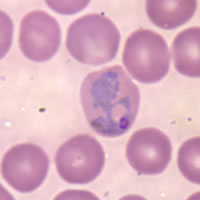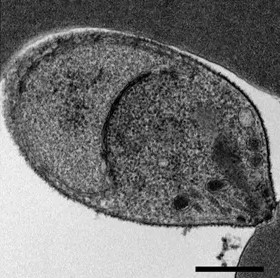|
List Of Plasmodium Species Infecting Primates
The ''Plasmodium'' species infecting primates include the parasites causing malaria in humans. Species infecting humans Common infections *'' Plasmodium falciparum'' (the cause of malignant tertian malaria) *''Plasmodium vivax'' (the most frequent cause of benign tertian malaria) *''Plasmodium ovale curtisi'' (another, less frequent, cause of benign tertian malaria) *''Plasmodium ovale wallikeri'' (another, less frequent, cause of benign tertian malaria) *''Plasmodium malariae'' (the cause of benign quartan malaria) *''Plasmodium knowlesi'' (the cause of severe quotidian malaria in Southeast Asia) Rare cases While infection of humans by other species is known, they are quite rare, in some instances, only a single case. In a number of the cases, the means of infection is unknown, and may be due to accident, i.e. infection by laboratory equipment or a bite by an animal. With the use of the polymerase chain reaction additional species have been and are still being identifie ... [...More Info...] [...Related Items...] OR: [Wikipedia] [Google] [Baidu] |
Eukaryota
Eukaryotes () are organisms whose cells have a nucleus. All animals, plants, fungi, and many unicellular organisms, are Eukaryotes. They belong to the group of organisms Eukaryota or Eukarya, which is one of the three domains of life. Bacteria and Archaea (both prokaryotes) make up the other two domains. The eukaryotes are usually now regarded as having emerged in the Archaea or as a sister of the Asgard archaea. This implies that there are only two domains of life, Bacteria and Archaea, with eukaryotes incorporated among archaea. Eukaryotes represent a small minority of the number of organisms, but, due to their generally much larger size, their collective global biomass is estimated to be about equal to that of prokaryotes. Eukaryotes emerged approximately 2.3–1.8 billion years ago, during the Proterozoic eon, likely as flagellated phagotrophs. Their name comes from the Greek εὖ (''eu'', "well" or "good") and κάρυον (''karyon'', "nut" or "kernel"). E ... [...More Info...] [...Related Items...] OR: [Wikipedia] [Google] [Baidu] |
Plasmodium Eylesi
''Plasmodium eylesi'' is a parasite of the genus ''Plasmodium'' subgenus ''Plasmodium''. Like all ''Plasmodium'' species ''P. eylesi'' has both vertebrate and insect hosts. The vertebrate hosts for this parasite are mammals. Description The parasite was first described by Warren ''et al.'' in 1965.Warren McW., Bennett G.F., Sandosham A.A. and Coatney G.R. (1965) ''Plasmodium eylesi'' sp. nov., a tertian malaria parasite from the white-handed gibbon, ''Hylobates lar''. Ann. Trop. Med. Parasit. 59: 500-508Warren, McW., Bennett, G.F., and Sandosham A.A., 1965. A new malaria parasite from the white-handed gibbon, ''Hylobates lar lar'' in Malaya. Singapore Med. J. 6:50 and is named after the malariologist Dr. Don E. Eyles, Father of the Apollo computer engineer Don Eyles. It is believed that this species is related to '' Plasmodium hylobati'', '' Plasmodium jefferyi'' and '' Plasmodium youngi'' but this putative relationship awaits examination by DNA based methods. The parasit ... [...More Info...] [...Related Items...] OR: [Wikipedia] [Google] [Baidu] |
Plasmodium Knowlesi
''Plasmodium knowlesi'' is a parasite that causes malaria in humans and other primates. It is found throughout Southeast Asia, and is the most common cause of human malaria in Malaysia. Like other ''Plasmodium'' species, ''P. knowlesi'' has a life cycle that requires infection of both a mosquito and a warm-blooded host. While the natural warm-blooded hosts of ''P. knowlesi'' are likely various Old World monkeys, humans can be infected by ''P. knowlesi'' if they are fed upon by infected mosquitoes. ''P. knowlesi'' is a eukaryote in the phylum Apicomplexa, genus ''Plasmodium'', and subgenus ''Plasmodium''. It is most closely related to the human parasite ''Plasmodium vivax'' as well as other ''Plasmodium'' species that infect non-human primates. Humans infected with ''P. knowlesi'' can develop uncomplicated or severe malaria similar to that caused by ''Plasmodium falciparum''. Diagnosis of ''P. knowlesi'' infection is challenging as ''P. knowlesi'' very closely resembles other spe ... [...More Info...] [...Related Items...] OR: [Wikipedia] [Google] [Baidu] |
Plasmodium Joyeuxi
''Plasmodium joyeuxi'' is a parasite of the genus ''Plasmodium'' subgenus ''Vinckeia''. As in ''Plasmodium'' species, ''P. joyeuxi'' has both vertebrate and insect Insects (from Latin ') are pancrustacean hexapod invertebrates of the class Insecta. They are the largest group within the arthropod phylum. Insects have a chitinous exoskeleton, a three-part body ( head, thorax and abdomen), three ... hosts. The vertebrate hosts for this parasite are mammals. Taxonomy The parasite was first described by Ledger in 1928. Hosts The only known host for this species is the monkey '' Cercopithecis callitricus''. References joyeuxi {{plasmodium-stub ... [...More Info...] [...Related Items...] OR: [Wikipedia] [Google] [Baidu] |
Plasmodium Jefferyi
''Plasmodium'' is a genus of unicellular eukaryotes that are obligate parasites of vertebrates and insects. The life cycles of ''Plasmodium'' species involve development in a blood-feeding insect host which then injects parasites into a vertebrate host during a blood meal. Parasites grow within a vertebrate body tissue (often the liver) before entering the bloodstream to infect red blood cells. The ensuing destruction of host red blood cells can result in malaria. During this infection, some parasites are picked up by a blood-feeding insect (mosquitoes in majority cases), continuing the life cycle. ''Plasmodium'' is a member of the phylum Apicomplexa, a large group of parasitic eukaryotes. Within Apicomplexa, ''Plasmodium'' is in the order Haemosporida and family Plasmodiidae. Over 200 species of ''Plasmodium'' have been described, many of which have been subdivided into 14 subgenera based on parasite morphology and host range. Evolutionary relationships among different ''Pl ... [...More Info...] [...Related Items...] OR: [Wikipedia] [Google] [Baidu] |
Plasmodium Inui
''Plasmodium inui'' is a species of parasite, one of the species of simian ''Plasmodium'' that cause malaria in Old World monkeys. History This species was described in 1907 by Halberstaedter and von Prowazek. Epidemiology This species is found in ChinaHuang Y, Yang Z, Putaporntip C, Miao M, Wei H, Zou C, Jongwutiwes S, Cui L. (2010) Isolation and identification of a South China strain of ''Plasmodium inui'' from ''Macaca fascicularis''. Vet Parasitol and also the Celebes, Indonesia, Malaysia and the Philippines. Phylogenetics It is closely related to other 'quartan' ''Plasmodium'' species, including ''Plasmodium coatneyi'', ''Plasmodium cynomolgi'', '' Plasmodium fragile'', '' Plasmodium fieldi'', '' Plasmodium hylobati'', '' Plasmodium simiovale'' and ''Plasmodium vivax'' (which is a 'tertian' ''Plasmodium'' species). Life cycle The life cycle is typical of a species of the genus ''Plasmodium''. It has a 72-hour (or quartan) periodicity. Salivary gland sporozoites a ... [...More Info...] [...Related Items...] OR: [Wikipedia] [Google] [Baidu] |
Plasmodium Gorb
''Plasmodium'' is a genus of unicellular eukaryotes that are obligate parasites of vertebrates and insects. The life cycles of ''Plasmodium'' species involve development in a blood-feeding insect host which then injects parasites into a vertebrate host during a blood meal. Parasites grow within a vertebrate body tissue (often the liver) before entering the bloodstream to infect red blood cells. The ensuing destruction of host red blood cells can result in malaria. During this infection, some parasites are picked up by a blood-feeding insect (mosquitoes in majority cases), continuing the life cycle. ''Plasmodium'' is a member of the phylum Apicomplexa, a large group of parasitic eukaryotes. Within Apicomplexa, ''Plasmodium'' is in the order Haemosporida and family Plasmodiidae. Over 200 species of ''Plasmodium'' have been described, many of which have been subdivided into 14 subgenera based on parasite morphology and host range. Evolutionary relationships among different ''Plas ... [...More Info...] [...Related Items...] OR: [Wikipedia] [Google] [Baidu] |
Plasmodium Gora
''Plasmodium'' is a genus of unicellular eukaryotes that are obligate parasites of vertebrates and insects. The life cycles of ''Plasmodium'' species involve development in a blood-feeding insect host which then injects parasites into a vertebrate host during a blood meal. Parasites grow within a vertebrate body tissue (often the liver) before entering the bloodstream to infect red blood cells. The ensuing destruction of host red blood cells can result in malaria. During this infection, some parasites are picked up by a blood-feeding insect (mosquitoes in majority cases), continuing the life cycle. ''Plasmodium'' is a member of the phylum Apicomplexa, a large group of parasitic eukaryotes. Within Apicomplexa, ''Plasmodium'' is in the order Haemosporida and family Plasmodiidae. Over 200 species of ''Plasmodium'' have been described, many of which have been subdivided into 14 subgenera based on parasite morphology and host range. Evolutionary relationships among different ''Pl ... [...More Info...] [...Related Items...] OR: [Wikipedia] [Google] [Baidu] |
Plasmodium Gonderi
''Plasmodium'' is a genus of unicellular eukaryotes that are obligate parasites of vertebrates and insects. The life cycles of ''Plasmodium'' species involve development in a blood-feeding insect host which then injects parasites into a vertebrate host during a blood meal. Parasites grow within a vertebrate body tissue (often the liver) before entering the bloodstream to infect red blood cells. The ensuing destruction of host red blood cells can result in malaria. During this infection, some parasites are picked up by a blood-feeding insect (mosquitoes in majority cases), continuing the life cycle. ''Plasmodium'' is a member of the phylum Apicomplexa, a large group of parasitic eukaryotes. Within Apicomplexa, ''Plasmodium'' is in the order Haemosporida and family Plasmodiidae. Over 200 species of ''Plasmodium'' have been described, many of which have been subdivided into 14 subgenera based on parasite morphology and host range. Evolutionary relationships among different ''Pl ... [...More Info...] [...Related Items...] OR: [Wikipedia] [Google] [Baidu] |
Plasmodium Georgesi
''Plasmodium georgesi'' is a parasite of the genus ''Plasmodium'' subgenus ''Plasmodium''. Like all ''Plasmodium'' species ''P. georgesi'' has both vertebrate and insect hosts. The vertebrate hosts for this parasite are mammals. Description This species was first described by Poirriez ''et al.'' in 1993. The trophozoites have long crescent-shaped nuclei (surface area 2.18 +/- 0.25 square micrometres). The pigment is stored as short rods. Geographical occurrence ''Plasmodium georgesi'' has been found in the Central African Republic. Clinical features and host pathology ''Plasmodium georgesi'', '' Plasmodium petersi'' and ''Plasmodium gonderi ''Plasmodium'' is a genus of unicellular eukaryotes that are obligate parasites of vertebrates and insects. The life cycles of ''Plasmodium'' species involve development in a blood-feeding insect host which then injects parasites into a vert ...'' are the only ''Plasmodium'' species found to date (2008) in ''Cercocebus'' monkeys ... [...More Info...] [...Related Items...] OR: [Wikipedia] [Google] [Baidu] |
Plasmodium Girardi
''Plasmodium girardi'' is a malaria parasite affecting lemurs. It was described in Madagascar in 1951 in ''Eulemur rufus'', the red-fronted lemur. It is named after Georges Girard, head of the Institut Pasteur in Antananarivo Antananarivo (French language, French: ''Tananarive'', ), also known by its colonial shorthand form Tana, is the Capital city, capital and largest city of Madagascar. The administrative area of the city, known as Antananarivo-Renivohitra ("An .... It is one of four ''Plasmodium'' species described in lemurs before 1975; others were '' Plasmodium foleyi'' and '' Plasmodium lemuris''. References {{reflist girardi Malaria ... [...More Info...] [...Related Items...] OR: [Wikipedia] [Google] [Baidu] |
Plasmodium Fragile
''Plasmodium'' is a genus of unicellular eukaryotes that are obligate parasites of vertebrates and insects. The life cycles of ''Plasmodium'' species involve development in a blood-feeding insect host which then injects parasites into a vertebrate host during a blood meal. Parasites grow within a vertebrate body tissue (often the liver) before entering the bloodstream to infect red blood cells. The ensuing destruction of host red blood cells can result in malaria. During this infection, some parasites are picked up by a blood-feeding insect (mosquitoes in majority cases), continuing the life cycle. ''Plasmodium'' is a member of the phylum Apicomplexa, a large group of parasitic eukaryotes. Within Apicomplexa, ''Plasmodium'' is in the order Haemosporida and family Plasmodiidae. Over 200 species of ''Plasmodium'' have been described, many of which have been subdivided into 14 subgenera based on parasite morphology and host range. Evolutionary relationships among different ''Pl ... [...More Info...] [...Related Items...] OR: [Wikipedia] [Google] [Baidu] |




.jpg)